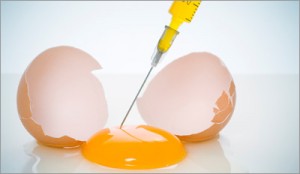Molecular Gastronomy: Experiments You Can Eat
by
 The last thing most of us think about when pulling a tube out of the centrifuge or taking a vial out of the desiccators is eating it. Unless you’re willing to grow a third arm out of your back, consuming your experiments should never cross your mind…
The last thing most of us think about when pulling a tube out of the centrifuge or taking a vial out of the desiccators is eating it. Unless you’re willing to grow a third arm out of your back, consuming your experiments should never cross your mind…
Or should it…
The field of Molecular Gastronomy would beg to differ. Simply put, molecular gastronomy is a scientific discipline that examines the physical and chemical changes that take place when food is cooked.
Although the discipline was created over 20 years ago, it has recently gained popularity, due in part to it’s exposure on a number of reality-based cooking shows on television. But don’t let the reality-tv association fool you, this field is serious about science. Chefs carefully manipulate time, temperature, concentration and moisture level of their ingredients and document the results in a way that would make a PI proud. Inventive techniques, like cooking meat for 24 hours at 50C, have emerged that greatly enhance the flavor and texture of food. Ingredients such as calcium chloride, sodium alginate and sake, used to create “synthetic caviar”, often look more like they’d be purchased in a chemistry stock room than in a grocery store.
Regarded as one of the world’s best chefs, Heston Blumenthal (Chef/Owner, The Fat Duck, UK) features menu items such as “The Not-so-Full English Breakfast” (liquid nitrogen-scrambled eggs with bacon ice cream and hot&iced tea) and “Powdered Anjou Pigeon” (Blood pudding and confit of entrails). The key to the meals is not only a boundless imagination, but also an impressive technical savvy.
Interestingly, despite the field’s origin as “Molecular gastronomy”, many top chefs reject the term, preferring to use “scientific gastronomy”, “culinary alchemy” or “sensory design”. In all three cases, you notice the one word they’ve purged…
Quoting an article published in Time magazine earlier this year “’Molecular gastronomy sounds scary,’ said Harold McGee, who writes regularly on the science of cooking for The New York Times… ‘If it were called something else, it wouldn’t make you think there’s something there you don’t know or can’t trust. But the moment you start talking about molecules, about these particles that you can’t see, people begin to get concerned.’”
I’ve had some bad days in lab where molecules terrified me, but I’m sticking with “molecular gastronomy.” Regardless of what you call this discipline, it’s awe-inspiring dishes represent what’s possible when careful experimentation is combined with limitless imagination. Unfortunately, the evolution of the name suggests that society is still suspicious and afraid of what we do. This misconception is our responsibility, as scientists, to change. (Until then, I hope people don’t find out the iPhone is made of molecules- that could kill it.)
Ever eaten a meal prepared using molecular gastronomy techniques? Or better yet, tried to prepare one? Who’s to blame for society’s inherent fear of molecules and science? Who’s job is it to fix?


[email protected]
wrote on August 5, 2009 at 3:38 pm
We have small underground restaurant movement here in St. Louis, which I recently joined. One of the main goals is to allow for this type of experimentation! The dishes are not something you would eat everyday or even think to try but are often delicious and exciting.
Patrick Jones
wrote on September 27, 2009 at 3:52 am
I am a Culinary Instructor at a local St Louis Culinary school, I am currently spending time with my students and teaching them a little molecular gastronomy. Feel free to contact me at [email protected]
Shane
wrote on November 5, 2011 at 10:02 pm
We are attempting to do this at Iowa State University but I am from St. Louis as well and would live to hear about this movement
Kristy
wrote on August 7, 2009 at 3:41 pm
Hi Katie! i'm in St. Louis. I'd be interested to hear about the movement.
[email protected]
wrote on August 11, 2009 at 1:19 pm
@Kristy: e-mail me at [email protected] and I will give you all the details!
alan@benchfly
wrote on August 11, 2009 at 6:43 pm
test
[email protected]
wrote on August 10, 2009 at 4:02 pm
@Kristy: e-mail me at [email protected] and I'll give you the details!
[email protected]
wrote on August 11, 2009 at 1:48 pm
@Kristy: e-mail me at [email protected] and I'll give you all the details!
alan@benchfly
wrote on August 11, 2009 at 5:50 pm
Anyone know of a place in Boston?
[email protected]
wrote on August 11, 2009 at 6:10 pm
@Kristy: email me at [email protected] and I'll give you all the details!
leslie
wrote on August 12, 2009 at 3:34 am
The pastry chef, Alex Stupak, at WD-50 the most notable molecular gastronomic restaurant here in NYC (Lamb belly, eggplant, date, smoked feta all on one dish!) worked at Clio in Boston. There's a start. And if that doesn't work out for you, just call WD-50 and see if the owner Wylie Dufresne can freeze dry one of his insane creations.
Recipes: Chemistry You Can Eat | BenchFly Blog
wrote on December 2, 2010 at 4:51 pm
[…] Molecular Gastronomy: Experiments You Can Eat – think research and cooking have a lot in common? So do the chefs pioneering this emerging style of kitchen chemistry […]